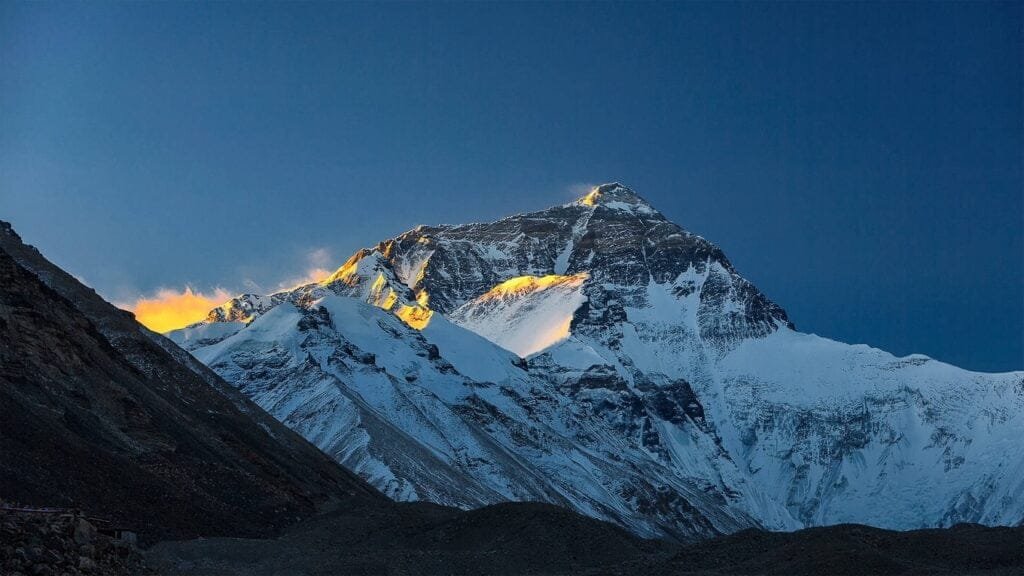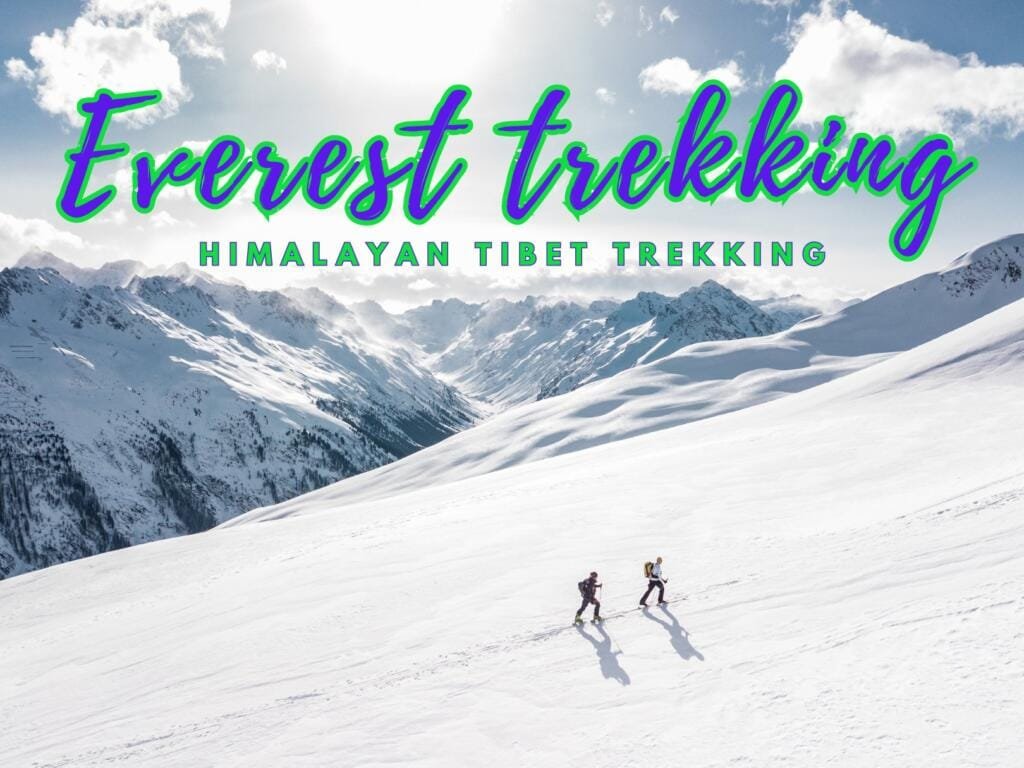The Majesty of Mount Everest
Mount Everest, often simply called “Everest,” stands as the principal peak of the Himalayas. The name Chomolungma (ཇོ་མོ་གླང་མ) derives from Tibetan words “Cho-mo,” meaning “goddess,” and “glang-ma,” meaning “third,” hence being called Chomolungma ( 珠穆朗玛峰) or the “Third Goddess” by the local Tibetan community. Straddling the border between China and Nepal, its northern part lies within Tingri County of Tibet, China, and its southern part in Nepal, with its summit reaching into the Chinese territory. Mount Everest is renowned as the highest mountain peak in the world.

The Third Goddess Unveiled
Tibetan Buddhist art depicts the Third Goddess, or the deity of Everest, known as Miyo Lozangma, as a yellow goddess riding a golden tiger. In her right hand, she holds a bowl filled with grains and with her left, she makes a gesture of offering treasures. She governs earthly treasures and wealth, providing material wisdom to the people, thus earning the title “Goddess of Food Sovereignty.” She is a third goddess among the Five Tsheringma sisters. Consequently, every Sherpa who undertakes the journey to climb Mount Everest offers prayers to Miyo Lo Zangma, (མི་གཡོ་བློ་བཟང་མ) seeking her blessing for safety and protection throughout their ascent.
The Historical Names of Everest
Throughout history, Everest has been known by various names such as” 珠穆朗玛峰” in Chinese, and “Sagarmatha” in Nepali. Later, under British supervision, the Survey of India named the peak after its former Surveyor General, George Everest, despite his objections to having the mountain named after him. In 1952, the Chinese government officially renamed it “Qomolangma” With a rock height of 8,848 meters, Everest reigns as the pinnacle of the world’s mountains.
A Realm of Giants
Surrounded by an imposing array of peaks within a 20-kilometer radius, Everest is part of a landscape where more than 40 peaks exceed 7,000 meters in height. Notable among these are Lhotse (8,516 meters, the world’s fourth-highest peak) just 3 kilometers to the south and Makalu (8,463 meters, the world’s fifth-highest) to the southeast. This area forms a breathtaking spectacle of towering mountains and rugged beauty.
The Everest Ecosystem
Mount Everest’s massif resembles a giant pyramid, with the snow line ranging from 5,800 to 6,200 meters on the north side, and 5,500 to 6,100 meters on the south. The surrounding area, spanning 500 square kilometers, is home to 548 glaciers covering 1,600 square kilometers, with an average thickness of 120 meters, and in places, the ice exceeds 300 meters thick.
Everest not only symbolizes the ultimate mountaineering challenge but also stands as a sacred figure, deeply revered in the local culture and spirituality. Its formidable presence and the legends that surround it continue to inspire awe and respect among people from around the globe, making it a centerpiece of Himalayan mystique and allure.

Mount Everest: The Third Pole and a Climber’s Ultimate Dream
The Glaciers of Everest’s Northern Slope
Among the majestic landscape of Mount Everest, the northern slope is adorned with 217 glaciers, including the renowned Rongbuk, Gelongba, Kabula, and Lhakpa glaciers. This area also showcases features from three ice ages and two interglacial periods, with ice phenomena like cirques, arêtes, and seracs dotting the landscape. Below the snowline, ice towers as high as 40 to 50 meters stand amidst deep ice caves and winding ice streams, presenting a scene of dazzling diversity.
The Ecological Wonderland
The snowline on Mount Everest ranges from 4,500 to 6,000 meters, higher on the north and lower on the south. The southern slope, with its richer precipitation, hosts a variety of ecosystems: tropical monsoon forests below 1,000 meters, subtropical evergreen forests between 1,000 and 2,000 meters, temperate forests above 2,000 meters, and alpine meadows above 4,500 meters. The northern slope primarily features alpine meadows, with forests and shrubs below 4,100 meters. This diverse habitat is home to peacocks, gibbons, Tibetan bears, snow leopards, and Tibetan antelopes, among other rare and exotic fauna.
The Flag Cloud: A Natural Wonder
Everest’s summit is eternally snow-capped, often giving rise to a white cloud banner, known as the “Flag Cloud.” This phenomenon typically appears after sunrise, most frequently between 11 AM and 3 PM. The Flag Cloud, a unique ornament crafted by Everest’s altitude and topography, can vary in shape, resembling flags, waves, rivers, or galloping horses, making it one of Everest’s natural spectacles. Its movement and height can even indicate the strength of the high-altitude winds, serving as “the world’s highest wind vane” and revered by explorers as “the Veil of the Holy Mother.”
Climatic Challenges
Mount Everest is known as the “Third Pole,” with its summit’s temperatures regularly dropping below -30 to -40 degrees Celsius year-round, and winds can reach up to 90 meters per second. The region experiences a rainy season from early June to mid-September, marked by frequent storms, fog, and unpredictable snow, making the climate quite harsh. Conversely, the period from mid-November to mid-February sees the lowest temperatures, reaching down to -50 degrees Celsius, with average temperatures around -30 degrees Celsius. The transition seasons, from early March to late May (spring) and from early September to late October (autumn), offer the best weather windows for climbing.
The Climber’s Paradise
Everest has been the ultimate goal for mountaineers, with two main routes to its summit: the more challenging north slope from China and the gentler south slope from Nepal. The Chinese mountaineering team successfully reached the summit via the north slope on May 25, 1960, and again on May 27, 1975. On May 5, 1988, a joint Chinese, Japanese, and Nepalese team accomplished the historic feat of ascending Everest from both the north and south slopes.
Centered around Everest, the “Qomolangma National Nature Preserve” was established, protecting not only Everest but also Lhotse, Nuptse, Cho Oyu, and various valleys like Changtang, Gama, Rongxar, Zhangmu, and Gyirong. The preserve is a haven for biodiversity, hosting 2,348 species of higher plants, 53 mammal species, 206 bird species, 8 amphibian species, 6 reptile species, and 5 fish species, along with over 160 kinds of medicinal plants across more than 50 families.
Mount Everest, standing as a testament to Earth’s natural beauty and the spirit of adventure, continues to fascinate and challenge humanity, embodying the sheer force and majesty of nature.

Essential Tips for Visiting Mount Everest
Ticketing and Transportation Fees
Everest operates on a “one-ticket” system, with different rates for peak and off-peak seasons. Drivers enter for free, but there’s an environmental fee for vehicles. Additionally, the eco-friendly bus from Rongbuk Monastery to the Base Camp (8 km) also requires a fee.
Getting There
Direct bus services to Everest Base Camp are available from Shigatse. For hitchhiking, travelers can take a vehicle to Lhatse, then find a ride to the Rongbuk Monastery via the Rulag border checkpoint, and onwards to Everest. This method can be challenging; thus, it’s recommended to arrange shared transportation from Lhasa, Shigatse, or New Tingri.
Travel 11 km along the China-Nepal Highway from Shelkar Town, turn left at the Everest Conservation Area sign, and shortly you’ll reach the climbing checkpoint for permit verification. After leaving the checkpoint, a 30 km drive will bring you to the famous Gawu La Pass, adorned with prayer flags, offering spectacular views of four 8,000-meter-plus peaks lined up from left to right.
Trekking to Base Camp
It’s possible to trek from Tingri to Everest Base Camp, covering about 70 km in 3-4 days, with accommodations available in villages along the way. Camping is an option, but be sure to bring stoves and tents. The best months for trekking are April to October.
Accommodation and Souvenirs
The only lodging near Everest is in the tented area of Base Camp, 2 km south of Rongbuk Monastery, which is chargeable and offers food at a higher price. Children at the base camp sell fossils with imprints of snails and fish, making for valuable collectibles.

Climate and Best Time to Visit
The best times for tourism and climbing are from early April to the end of June and from early September to the end of October. Winter is too cold for Everest excursions, and July to August is the rainy season, obscuring views of the peak.
Preparing for the Cold
Visitors should prepare warm clothing for the cold and wind. Protect your camera from the cold and bring a tripod for capturing sunrise and sunset scenes. The months of April to June and September to November offer the best conditions for photographing Everest, especially in the early morning and evening.
Travel Documents
Traveling to Everest requires a border permit, which can be obtained at your place of residence or through a travel agency in Lhasa or Shigatse with your ID card. These tips are designed to help visitors navigate the challenges and maximize the enjoyment of their Everest adventure, ensuring a memorable experience amidst the breathtaking landscapes of the world’s highest peak.
